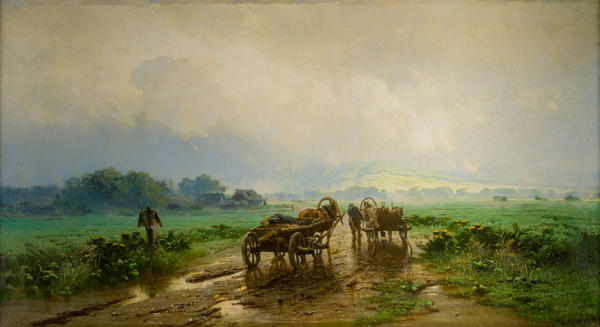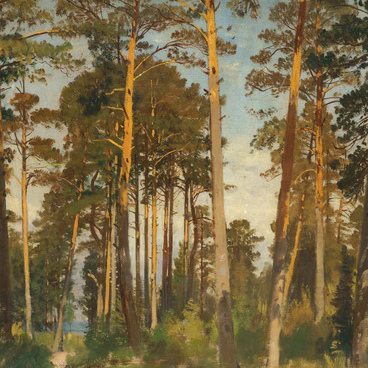Ivan Petrovich Stefanovsky was a Russian realist painter, a follower of the school of landscape painting founded by Alexei Savrasov. From a young age, the artist showed a great talent, but it was not destined to develop to the full - that was prevented by extreme poverty and early death at the age of 28 due to a serious illness. Nevertheless, the painter left behind a series of outstanding works, imbued with deep drama and tragic experiences.
Stefanovsky’s whole life was haunted by severe hardships. In 1868, he entered the Imperial Academy of Arts, where he demonstrated outstanding results. A number of works of the young artist received high evaluations of teachers, some of them were acknowledged by awards, but poverty and tuberculosis, that was worsening in the rainy climate, did not allow him to succeed in the capital. In 1875, Ivan Petrovich had to leave St. Petersburg and go to his hometown Penza.
In the province, the artist could not provide a decent existence, he starved for months. The management of the Academy of Arts eventually helped its talented student, but it was too late. Exhausted by illness and poverty, Stefanovsky died.
The life of the artist, full of hardships, could not but affect his work. In the painting After a Heavy Rain the internal tragedy and the sense of hopelessness reached their climax. The mood of the work is a deep sorrow, which is manifested in everything: in the road washed out by the rain, in the carts that barely move along the mud road loaded with chattels and a dead body, and in the wayside cross at the edge of the road.
The image of a road with poor people was a frequent theme for artists of the time. Roads with displaced persons, beggars and vagrants became a symbol of hopelessness of life. The only thing that gives hope to the viewer is the typical Russian landscape, beautiful at any time of the year. In order to highlight the foreground with the meticulously painted bushes, the road, dull people and dirty carts, the artist painted the sky in the background, with sun rays, barely shining through lead gray clouds and illuminating the horizon.
In this work, Stefanovsky managed to combine the subtle lyricism of the Savrasov-style painting and the acute social problems that the Itinerants were addressing. The mood of the painting reminds the work Vladimirka by another outstanding master of landscape, Isaak Ilyich Levitan. Although the road is in the focus of both paintings, the works are similar not so much in composition, but rather in the precise depiction of the symbol of Russian life. Another thing that makes the paintings similar is the outstanding artistic quality of both of them.
As for the exact determination of the date of creation of After a Heavy Rain, one can take the painting Return of Workers to the Village in the Rain, painted in 1874, as a starting point. Both paintings were created almost at the same time, they are united by the theme of rain, so much favored by the artist, which allows to suggest that After a Heavy Rain could be painted in the same year.
Stefanovsky’s whole life was haunted by severe hardships. In 1868, he entered the Imperial Academy of Arts, where he demonstrated outstanding results. A number of works of the young artist received high evaluations of teachers, some of them were acknowledged by awards, but poverty and tuberculosis, that was worsening in the rainy climate, did not allow him to succeed in the capital. In 1875, Ivan Petrovich had to leave St. Petersburg and go to his hometown Penza.
In the province, the artist could not provide a decent existence, he starved for months. The management of the Academy of Arts eventually helped its talented student, but it was too late. Exhausted by illness and poverty, Stefanovsky died.
The life of the artist, full of hardships, could not but affect his work. In the painting After a Heavy Rain the internal tragedy and the sense of hopelessness reached their climax. The mood of the work is a deep sorrow, which is manifested in everything: in the road washed out by the rain, in the carts that barely move along the mud road loaded with chattels and a dead body, and in the wayside cross at the edge of the road.
The image of a road with poor people was a frequent theme for artists of the time. Roads with displaced persons, beggars and vagrants became a symbol of hopelessness of life. The only thing that gives hope to the viewer is the typical Russian landscape, beautiful at any time of the year. In order to highlight the foreground with the meticulously painted bushes, the road, dull people and dirty carts, the artist painted the sky in the background, with sun rays, barely shining through lead gray clouds and illuminating the horizon.
In this work, Stefanovsky managed to combine the subtle lyricism of the Savrasov-style painting and the acute social problems that the Itinerants were addressing. The mood of the painting reminds the work Vladimirka by another outstanding master of landscape, Isaak Ilyich Levitan. Although the road is in the focus of both paintings, the works are similar not so much in composition, but rather in the precise depiction of the symbol of Russian life. Another thing that makes the paintings similar is the outstanding artistic quality of both of them.
As for the exact determination of the date of creation of After a Heavy Rain, one can take the painting Return of Workers to the Village in the Rain, painted in 1874, as a starting point. Both paintings were created almost at the same time, they are united by the theme of rain, so much favored by the artist, which allows to suggest that After a Heavy Rain could be painted in the same year.



